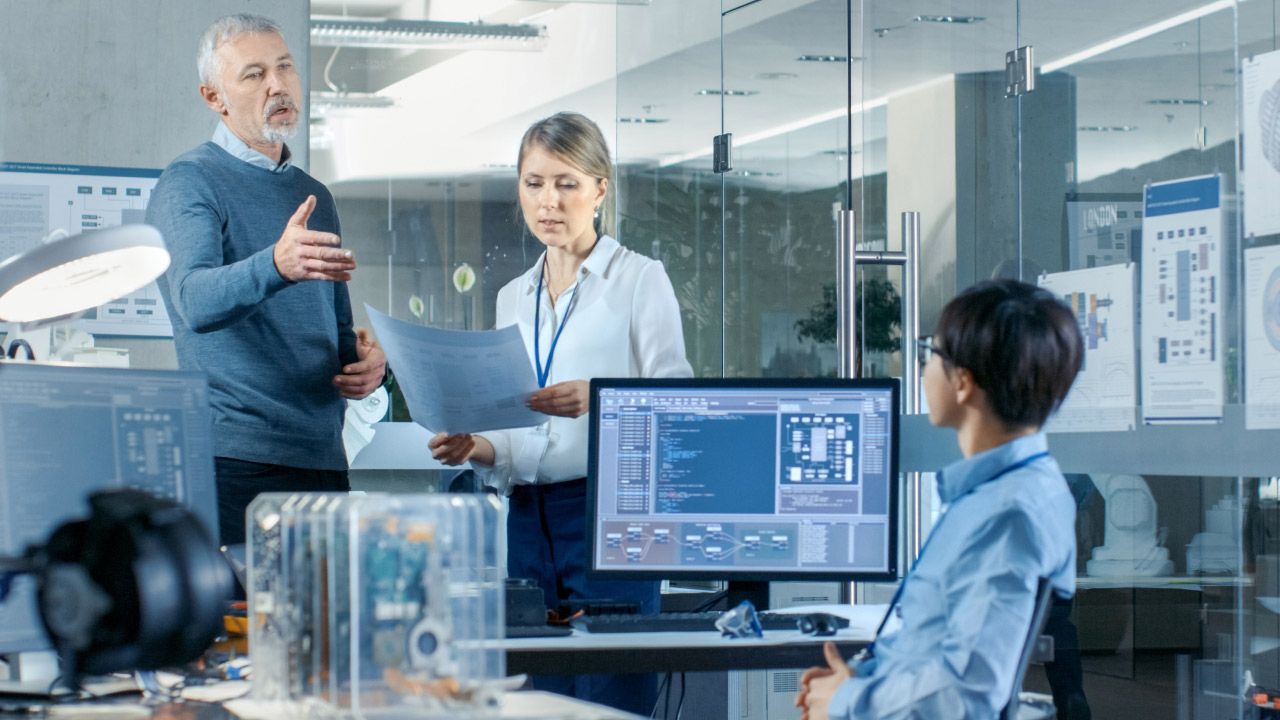The Software Development Life Cycle (SDLC): 7 Phases And 5 Models
By Marco Franzoni • May 20, 2024

Introduction: Understanding the Software Development Life Cycle (SDLC)
In today's rapidly evolving digital landscape, the Software Development Life Cycle (SDLC) stands as a pivotal framework, guiding the creation of high-quality software across various industries. At its core, the SDLC is a systematic process designed to ensure the efficient and effective development, deployment, and maintenance of software. This methodology not only supports software developers in meeting customer expectations but also adapts to complex projects and the dynamic nature of technological advancement.
Understanding the SDLC is crucial for anyone involved in software development, from project managers and engineers to the development teams at the helm of crafting cutting-edge applications. By integrating principles such as the Agile model and security testing, the SDLC helps mitigate risks and enhance system performance, ensuring that software not only meets but exceeds the rigorous demands of today’s production environments.
Join us as we delve into the intricacies of the SDLC, exploring its phases, models, and its pivotal role in the modern software industry.
The Importance of SDLC
Why is SDLC important?
In the ever-competitive software industry, the Software Development Life Cycle (SDLC) is indispensable for creating high-quality software that stands the test of time and technology shifts. This structured approach to software development ensures that every phase—from initial planning to final deployment—is meticulously managed and executed, reducing risks and maximizing efficiency.
The SDLC is crucial as it provides a repeatable and standardized process that helps development teams understand requirements, plan accurately, and execute effectively. By adhering to the stages of the SDLC, teams can predict outcomes more accurately, manage changes smoothly, and deliver software that meets or exceeds customer expectations. This lifecycle not only aids in maintaining software but also in its systematic enhancement and adaptation in response to new challenges and technologies.
Furthermore, the SDLC framework supports the integration of security practices and testing phases throughout development, thereby fostering the production of more secure and robust applications. As businesses increasingly rely on software to drive operations and innovation, the role of the SDLC in supporting scalable, secure, and efficient software development becomes all the more critical, ensuring that projects are delivered on time, within budget, and without compromising on quality.

The Seven Phases of the SDLC
The Software Development Life Cycle (SDLC) encompasses seven distinct phases that guide the transformation of a software concept into a fully functional application. Each phase plays a crucial role in ensuring that the developed software is robust, secure, and aligned with user and business requirements. Here is a detailed look at each of these phases:
Planning and Requirement Analysis
This initial stage forms the foundation of the project. It involves gathering input from all stakeholders, including project managers, developers, customers, and sales teams, to define clear objectives and create a detailed project plan. This phase addresses the scope, risks, timelines, and resources, setting the stage for a successful project lifecycle.
Define Requirements
Once the initial planning is complete, the next step is to detail the specific requirements of the software. This involves creating a Software Requirements Specification (SRS) document that serves as a blueprint for the entire project. The SRS includes all functional and non-functional requirements, from system performance needs to security expectations, ensuring every stakeholder’s needs are comprehensively documented.
Designing Architecture
During this phase, system architects and developers come together to propose a high-level design. They decide on a programming language, industry practices, and the overall system architecture including databases, hardware, and system interfaces. This phase is critical as it sets the design standards for the entire project and helps identify potential risks in early stages.
Code Test
Before moving into deeper testing phases, developers perform initial code testing to catch and fix bugs early in the development process. These tests, often unit tests, are vital for validating the functionality of individual components within the software.
Test the Product
After coding, the software undergoes a series of detailed tests to ensure it meets the requirements specified in the SRS. This testing phase may include integration testing, system testing, and functional testing to check for interactions between various components and compliance with the overall design.
Software Deployment
Once the software has passed all stages of testing, it’s ready for deployment. This phase can be conducted in stages depending on the business strategy, typically beginning in a limited or staging environment before full-scale production deployment. This staged deployment helps mitigate risks associated with direct deployment to the production environment.
Deployment and Maintenance of Products
The final phase involves maintaining and regularly updating the software to enhance its performance and security. Maintenance is an ongoing process that includes bug fixes, updates, and possibly new features to meet evolving customer needs. Regular system performance assessments and updates ensure the software remains functional and relevant in the changing technological landscape.
These seven phases of the SDLC are designed to ensure that every software project is executed with precision, from conceptualization through to maintenance, delivering high-quality software that meets both current and future demands of users and the market.
The Five Models of SDLC
Waterfall Model
The Waterfall model is one of the earliest SDLC models, featuring a sequential, linear process that flows steadily downwards through the phases of conception, initiation, analysis, design, construction, testing, deployment, and maintenance. This model is highly structured and is best suited for projects with well-defined requirements and where changes are infrequent. It provides a systematic, disciplined approach that is easy to understand and manage.
Agile Model
Contrasting sharply with the Waterfall model, the Agile model emphasizes flexibility and continuous improvement through iterative development. In this model, the project is broken down into small, manageable increments or sprints, allowing for frequent reassessment and adaptation of plans. This model thrives on customer interaction and satisfaction, making it ideal for projects requiring frequent updates to meet changing needs.
Iterative Model
The Iterative model focuses on an initial, simplified implementation, which exposes issues early on in the development process. Each iteration of the development cycle includes design, implementation, and testing phases, allowing for incremental enhancements based on feedback before the final full-scale implementation. This model is particularly useful for large projects that need to evolve in response to technological or market changes.
V-Shaped Model
The V-Shaped model extends the Waterfall model by emphasizing planning and execution in a sequential manner, with an added focus on testing. Each development phase has a directly associated testing phase, promoting a high level of discipline and rigorous validation. This model is well-suited for small projects with well-defined requirements, ensuring thorough testing and verification at each stage.
Spiral Model
The Spiral model combines elements of both design and prototyping in stages, in an effort to combine advantages of top-down and bottom-up concepts. It allows for incremental releases of the product, or incremental refinement through each iteration around the spiral. The Spiral model places a strong emphasis on risk analysis and aims to manage potential risks at various stages of the project. It is particularly useful for complex and high-risk projects where objectives may change in the midstream.
These models of the SDLC provide frameworks that guide teams in managing the complexities of software development, ensuring that the final product meets both customer expectations and performance standards, while effectively managing time, cost, and quality. Each model has its unique approach and is chosen based on the specific needs and circumstances of the project, underlining the versatility and adaptability of the SDLC in the software industry.

Integrating Best Practices and Security in SDLC
How can DevSecOps be integrated into SDLC?
DevSecOps, an approach that integrates security into all phases of the software development life cycle, enhances the traditional SDLC by embedding security checks and balances from the initial stages. By involving security teams early on, potential vulnerabilities can be identified and mitigated more effectively. This integration not only reduces the risk of security issues emerging later in the development process but also ensures that security is a continuous concern, rather than an afterthought. Regular code reviews, automated security testing, and continuous monitoring are part of this proactive approach, ensuring that each release is secure by design.
How does SDLC address security?
Security in SDLC is addressed by incorporating security assessments and testing phases at multiple points throughout the cycle. This begins with the requirement analysis phase, where security needs are defined and continues through the design, implementation, and testing phases. Techniques such as penetration testing, security assurance activities, and conducting security assessments are integrated into these phases. Additionally, the maintenance phase includes ongoing security updates and patches to respond to new vulnerabilities as they are discovered. This systematic approach to security ensures that software developed through the SDLC is not only functional but also resilient against both current and emerging security threats.
Through these practices, the SDLC promotes a security-conscious culture within development teams, ensuring that security considerations are an integral part of the development process and not merely an additional feature. This leads to more secure, reliable software applications that can better protect data and resist cyber threats, thereby maintaining software integrity and customer trust in a dynamic digital environment.

Comparison with Other Methodologies
SDLC vs STLC (Software Testing Lifecycle)
While the Software Development Life Cycle (SDLC) encompasses all aspects of software creation from initial planning to maintenance, the Software Testing Lifecycle (STLC) focuses specifically on the testing phases. STLC is a subset of SDLC that deals with testing parameters, ensuring each software product meets the required quality standards. While SDLC includes stages like planning, design, coding, and deployment, STLC rigorously examines each piece of software through multiple stages of testing to detect defects and ensure functionality, thereby enhancing the overall quality of the final product.
SDLC vs. systems development lifecycle
The term "systems development lifecycle" can often be confused with SDLC, but it generally refers to a broader spectrum of activities. This includes not only software development but also the planning, design, and deployment of hardware and other IT system components. The systems development lifecycle can encompass a range of methodologies beyond software development, including network architecture and server specification, making it more holistic compared to the more software-focused SDLC.
SDLC vs DevOps
DevOps is a modern extension of the SDLC principles, focusing on the continuous integration and continuous delivery (CI/CD) of software to speed up development and deployment cycles. While SDLC is methodical and often segmented into distinct phases, DevOps encourages ongoing collaboration between developers, operations teams, and even other departments such as quality assurance and security. This collaboration aims to enhance software quality, reduce development time, and respond more agilely to market changes. DevOps integrates automated processes to assist in quicker iterations of development, testing, and deployment, which contrasts with some of the more traditional, linear approaches seen in SDLC models like the Waterfall model.
These comparisons highlight the distinct roles and focuses of each methodology, showing how they can either complement each other or serve unique purposes within different types of software development projects. The choice of methodology often depends on the project scope, team size, and specific goals, underlining the importance of understanding their differences and strengths.
Choosing the Right SDLC Model
Which SDLC model is the best and most commonly used?
Determining the "best" SDLC model depends greatly on the project requirements, team dynamics, and organizational workflow. However, the Agile methodology has emerged as one of the most commonly used models in the software industry, especially in dynamic environments where client feedback and iterative testing play crucial roles in project success. Agile facilitates a flexible and iterative development process, allowing teams to adapt to changes quickly and efficiently.
The popularity of Agile stems from its ability to support continuous improvement and prioritize customer satisfaction with frequent updates and iterations. This model encourages collaboration and quick responses to change, which are critical in today’s fast-paced digital world. For many organizations, Agile represents a way to enhance project management and improve the delivery of high-quality software, making it a preferred choice among development teams worldwide.

Conclusion: Future Trends in Software Development
As we continue to navigate the complexities of the software industry, the importance of the Software Development Life Cycle (SDLC) remains more relevant than ever. The SDLC provides a structured approach to crafting high-quality software, ensuring that software development projects are not only efficient but also equipped to meet evolving software development goals. Looking ahead, the integration of advanced methodologies like AI and machine learning within the SDLC promises to further enhance predictive capabilities, automation, and customization in software development.
The ongoing adaptation of SDLC models, particularly with increased emphasis on security and rapid development cycles, highlights the industry’s commitment to innovation and continuous improvement. As the digital landscape evolves, so too will the strategies we employ to manage and execute software projects, ensuring that the SDLC remains at the forefront of technological advancement and a cornerstone in the software industry.